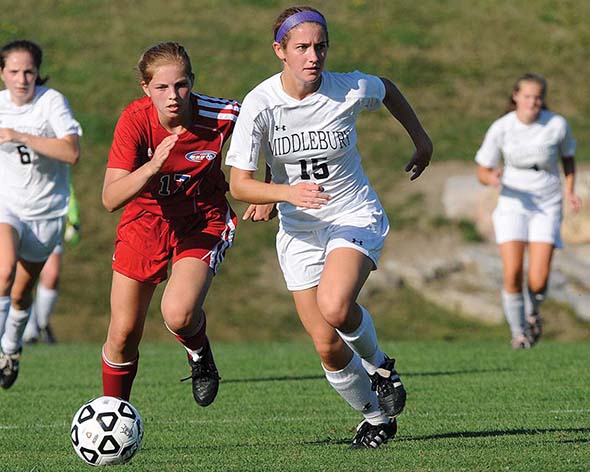
Patient Stories

LIKE TOO MANY, ANDI BOE TORE HER ACL – THIS IS HOW SHE RETURNED
RECENT MIDDLEBURY UNION High School graduate Andi Boe was well on her way to soccer season-high goal and assist totals last fall before suffering a season-ending injury in the fifth game of her senior year. After surgery and challenging rehab Boe returned to action in time to help the Tiger girls’ lacrosse team win a state championship.
Editor’s note: This is the first in a two-part series.
MIDDLEBURY — It was just a routine play, according to recent Middlebury Union High School graduate Andi Boe (pictured, above).
It happened in the fifth game of her final soccer season, on Sept. 19, 2017, at Rice Memorial High School. Boe, by her senior year already a multi-sport all-state athlete, had racked up seven goals and four assists in the Tigers’ first four games.
After soccer, Boe planned to add to her career totals of 51 goals and 62 assists in ice hockey, help the MUHS girls’ lacrosse team repeat as Division I champion, and then give college lacrosse a try.
The sky seemed the limit.
Then that afternoon Boe cut between two Rice opponents and touched the ball forward. One Rice player challenged her from the left, making what Boe insists was clean contact that bumped the Tiger all-star off course. The other Rice player closed in from the right, leaving Boe no space to land properly.
“I had no room to step and prevent myself from falling,” Boe recounted. “So with my foot still planted I went down. And I heard it. People on the sidelines heard it.
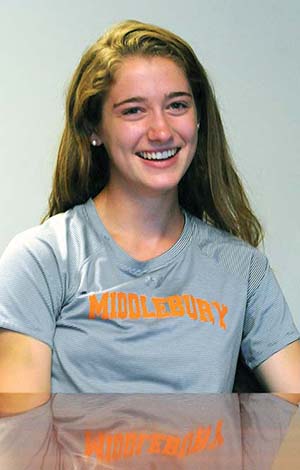
“People said it sounded like a pop. I heard more like a crack. It was a noise I’d never heard before from my knee.”
And she felt pain unlike anything she had ever known.
“I remember just lying on the ground screaming,” Boe said. “As I went off the field I remember having two separate thoughts in my head. One was my pet peeve — when people go down and are crying and screaming and then come back on 10 minutes later. And I was like, OK, you are not really hurt. One part of my brain was saying, wow, I’m going to be that kid when I step back on the field and play.
“And the other part of me was like, wow, I just tore my ACL.”
Just like that, Boe joined the surprising number of local athletes who have faced the multiple challenges of a torn anterior cruciate ligament (ACL), a key component of the knee joint. The story of how Andi Boe tackled the physical and psychological pain of the injury speaks not only to the resilience of one elite competitor, but also shines a light on what all-too-many athletes battle when they are taken off the field.
After that fateful collision on the Rice soccer pitch last September, Middlebury orthopedic surgeon and family friend Ben Rosenberg ordered an MRI that confirmed that Boe’s ACL, which runs horizontally through the knee joint, was torn.
As is often the case with an ACL tear there was other damage: Boe’s medial collateral ligament (MCL), which runs vertically, was strained, and she also had a tear in her meniscus cartilage, which helps cushion the knee joint.
Ultimately, after surgery, months of determined rehab, and one frightening setback, Boe’s senior year ended more happily than first expected: Another play that normally would have been routine for Boe bookended the Sept. 19 injury.
On May 23 Boe, with a brace on her knee, made a surprise return to the Tiger lacrosse lineup, a couple months after a scare almost triggered a second operation.
And 1:52 after the opening draw vs. visiting Mount Mansfield Boe curled clockwise from behind the opposing goal and did what she had done 70 times before, to go along with 57 assists — tossed the ball into the opposing net.
“My defender was out of position, and I crease-rolled and shot,” Boe said. “And the first thing I thought was, ‘I belong out here.’”
Although Boe remained at less than her full former speed, she went on to help the Tigers win that second straight D-I title, scoring three times as they prevailed in a 11-9 quarterfinal and once in a 13-10 final.
But just getting back on the field was a huge victory. Right after that first goal she saw Rosenberg, who was nearby with a camera because his daughter, Isabel, was as usual on the field with Boe.
“Ben Rosenberg was behind the net taking pictures, and he gave me two thumbs up,” she said.
Rosenberg explained his reaction, which also included a yell. For years he had been watching Andi and Isabel play soccer and lacrosse, often with Andi’s parents, Kathy and the late Kelly Boe, who three years ago died after being struck by a drunk driver while biking. Rosenberg spoke of a “a special responsibility” in caring for Andi Boe.
“Andi gets the ball on the right side of the net where she always is, and boom! Ninety seconds, score. God, it was awesome,” Rosenberg said. “She went right after it. It was pretty amazing.”
ACL VICTIMS
But what it took for Boe to reach that happy ending, both physically and psychologically, is probably the real story — for Boe and for the many other athletes who have torn their ACLs.
Just in recent memory many local athletes have gone down with the injury. Within a couple of weeks after Boe’s injury last fall Vergennes Union sophomore Emily Rooney, like Boe a standout soccer midfielder, and Middlebury College quarterback Jared Lebowicz both tore their ACLs.
In the fall of 2015, in the case that most closely parallels Boe’s, Tiger senior three-sport standout Oakley Gordon tore his ACL in a D-I football semifinal; he missed the basketball and baseball seasons. In 2013 Otter Valley senior soccer and basketball star Jessica Frazier suffered the injury in the OV basketball opener. In 2012 senior Tiger girls’ lacrosse player Liz Kelley went down during the D-I lax final much like Boe, after being bumped while carrying the ball.
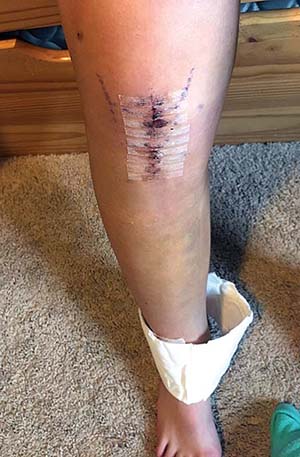
Statistics say Boe, Rooney, Kelley, and Frazier were more likely to tear their ACLs. According to sports-health.com females are at up to six times a greater risk than males, a trend experts most often attribute to muscular and structural differences in knees by gender.
The site states year-round female athletes who play soccer or basketball have an ACL tear rate of almost 5 percent, and about 70 percent of those are non-contact injuries resulting from “cutting, pivoting or landing on one leg.”
The challenges to a successful recovery start with a drastic surgery. “Basically you take an injured knee and then re-injure it when you do the ACL surgery,” Dr. Rosenberg said.
ACL surgeons replace the torn ligament by using cadaver tissue or a piece of either a patient’s hamstring tendon (from the back of the thigh) or patellar tendon (running below the knee and connecting to a lower leg bone).
Rosenberg said for “petite, young female athletes” like Boe the patellar tendon option is the best as it offers a lower chance of another tear. The downside is that using the patellar tendon means taking a small piece of bone on either end, a more invasive procedure that in turn means a more painful, longer rehab. (Surgery left a big scar on Boe’s knee, pictured last November, right.)
Rosenberg said he opted to leave the MCL tear alone because it would heal itself, and also not to operate on the meniscus tear because it was small and hard to reach, near an important nerve, and probably would not pose a problem.
The procedure left Boe with the challenges all ACL patients face: pain after surgery; at least six months of rehab and therapy before a return to even limited action; the loss of activities that provide sources of joy, even identity, to athletes; uncertainty about the recovery and future performance; and, often, feelings of isolation and frustration during the process.
HANDLING FRUSTRATION
Facing those issues, Boe first chose to stay with her teams. She only missed a handful of their soccer, hockey and lacrosse games. Experts say that’s one healthy way to deal with the psychological challenges.
For athletes a positive attitude and “social support” during recovery is critical, according to the American College of Sports Medicine’s website. It recommends “continued team participation and the resulting maintained sense of athletic self-identity.”
Boe said staying with her teams and friends helped.
“I don’t really know what I would have done otherwise. So that was a pretty easy decision,” she said.
Boe’s coaches also trusted her as an advisor, something that made her feel like a valued team member.
“All of my coaches from soccer, hockey and lacrosse were good about telling me if I saw something to talk to people about it. I was still able to contribute,” she said.
Her coaches — Wendy Leeds in soccer, Matt Brush in hockey and Brandi Whittemore in lacrosse — talked about Boe’s input to them and leadership for their teams.
“This was a kid who played pretty much every minute always,” Leeds said. “Then all of a sudden she was (next to me), and I just found her to be incredibly valuable that way. She’s just such a smart athlete, and she has such a game sense. She has the ability to see things.”
Brush said, “She made it very clear it was never about her not playing. It was about supporting her friends and her teammates in any way she could to help their experience, knowing that it was tearing her up inside not playing.”
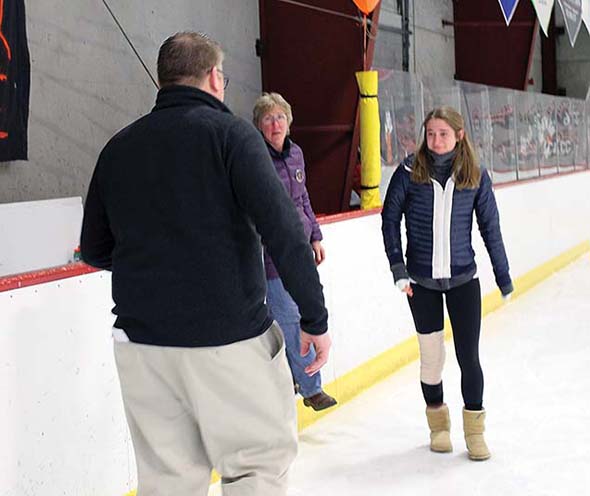
Boe’s input proved to be helpful, he added.
“Andi would come and whisper something in my ear, and be like, hey what do you think about that, and she would have good insight,” Brush said.
Whittemore remembered a talk Boe gave to the team the day before a game, at about the time when it looked like she would return.
“Just her message of never giving up and just being proud, and the importance of being on a team and how it was such a privilege to her, I think it touched the team,” Whittemore said.
But just because Boe could be with and help her teams didn’t mean it was easy. Sometimes she would talk to her mother or Brush when she was unhappy, and she advised anyone in her shoes to reach out to friends, family or mentors.
“I just had to let people know that I’d been going crazy sitting here having to watch these games. It should be that going to hockey was my release,” she said. “And instead I would just build up more frustration having to watch instead of play. Anything that should have helped me out was doing the opposite.”
Boe also spoke of how supportive her teammates were and how much it helped ease her frustration.
“Even people who weren’t injured (were) able to empathize about how much it sucks to stand there and watch,” she said. “It was still really hard. Because every day I would stand there and I would want them to do well, but at the same time I didn’t want to miss out on all that. When it was going poorly I was so frustrated and just wanted to be able to help. And when it was going well I just wanted to be a part of it. There was no point where I was standing there and going, ‘Oh, this is so satisfying.’”
Andi Boe, Part II: When an athlete goes down
Posted on July 5, 2018 | Addison Independent By Andy Kirkaldy
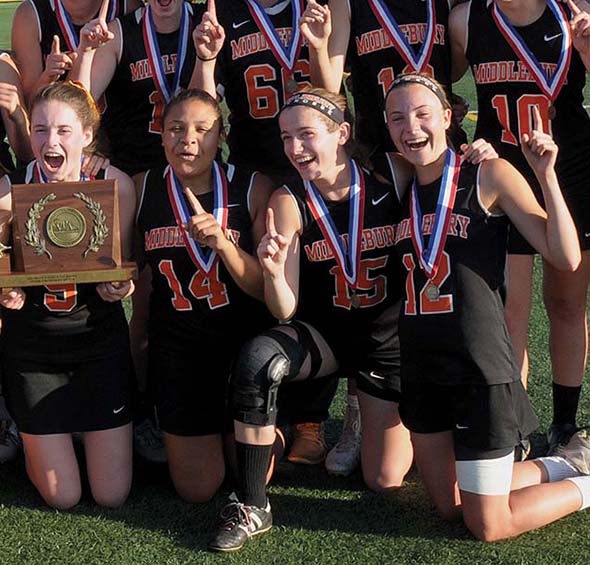
Below, in a courtesy photo, Boe is announced before the start of the Tiger soccer senior game last fall. Boe was injured in the fifth game of the soccer season and missed the rest of the soccer season and the entire ice hockey season.
Part two of a series. Part One, published on June 28, showed how in her senior soccer season Middlebury Union High School three-sport athlete Andi Boe suffered an anterior cruciate ligament knee injury, how common it is, how Middlebury surgeon Ben Rosenberg treated it, and how Boe faced some of the psychological challenges that come with being a sidelined athlete.
MIDDLEBURY — Five days after surgeon Ben Rosenberg operated this past November on Andi Boe’s right knee to repair a torn anterior cruciate ligament (ACL), Boe, a three-sport all-state athlete who had played in four state finals, faced a new challenge.
One of Vermont’s quickest high school female athletes, Boe struggled to meet her first post-op target when she met with Physical Therapist Matt Horne at Wells Physical Therapy in Middlebury.
“Matt had his hand two inches over my foot just trying to get me to touch it, and I couldn’t even pick my leg up,” Boe recalled. “But by the end of that day I could pick my leg up and down. It was so painful, but when I got out of there I felt like so satisfied because it was the first thing I accomplished.”
That was Boe’s first physical step in rehabbing a knee injured back on Sept. 19 during a soccer game. Her medial collateral ligament (MCL) was also strained, but not torn, and she also suffered a tear in her meniscus cartilage, which helps cushion the knee joint. Rosenberg had determined the MCL would heal itself, and that he should leave the meniscus tear alone because it was small, hard to reach and near a nerve.
After the injury, Boe remained on the sidelines with her sports teams. It was a step experts recommend and that, while difficult at times, helped her get support for the psychological challenges of being a sidelined athlete.
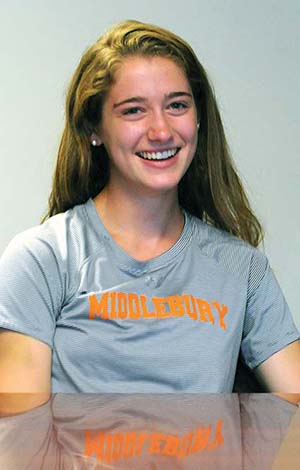
Boe said what also helped her keep a positive frame of mind was dedicating herself to rehab, including physical therapy, stationary biking and eventually running. She recommended that others recovering from ACL tears or other major injuries try to channel energy and frustration into rehab.
“I completely threw myself into doing everything I could to get better,” Boe said. “I never considered I wouldn’t give the same amount of effort that I had given to sports to my rehab.”
As Boe progressed, Horne did something experts also recommend to help athletes recover from major surgery: He incorporated activities that allowed Boe to feel like an athlete again.
“We would pass the soccer ball to get me on my toes, and do things that were applicable to what I like to do,” Boe said.
But PT sessions are just a tiny part of the post-surgery work required to recover athletic ability. Boe spent hours lifting weights, stationary biking, lunging and squatting, and jogging — “probably as much as I would have spent practicing sports.”
Sometimes friends would join her. Most often Boe was alone.
“Biking especially was tedious, when I would go down to the basement and it was just me and the walls, essentially,” she said.
Boe met milestones and checkpoints. She remembered being cleared for resistance biking, meaning it was harder to pedal.
“I was so sweaty. I hadn’t felt like that since before the injury, and that was the best feeling in the world,” Boe said. “I actually felt physically tired, not mentally from dealing with this.”
Then she was cleared to run, just for two minutes. It felt great, but reminded her what she couldn’t do.
“At the same time I was annoyed at myself for celebrating two minutes of running. I was like, c’mon, I used to be able to go forever,” Boe said.
The Setback
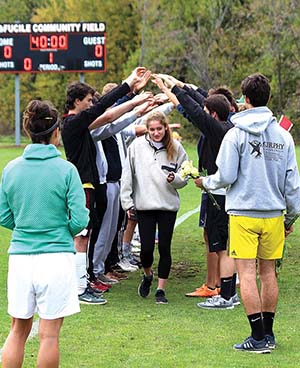
In the meantime, she had regular appointments with Rosenberg to monitor her knee. Its report card read as well as Boe’s at high school, nothing but As. Her rehab graphed straight up the chart.
Then came a Tuesday morning in late February.
“I had a normal workout on a Monday afternoon, and went to bed feeling great. And woke up on Tuesday and my knee was stuck in one position, like a little bent. I couldn’t straighten it at all,” she said.
It didn’t improve overnight, and she went in to Rosenberg’s office on Wednesday.
“They drained an ounce of fluid and it was still swollen,” Boe said. “That’s when we realized the meniscus still might really be an issue.”
Rosenberg, who has performed close to 700 ACL surgeries over 30 years, found himself second-guessing his decision not to repair Boe’s meniscus tear in November.
“The only thing that was hurting was the meniscus,” Rosenberg said. “And I was thinking maybe I made the wrong call, maybe I should go back in and fix it.”
But it was still a gray area. Rosenberg did not feel he could just tell Boe he should operate. And Boe felt she was back at square one, facing another procedure, crutches and baby-steps rehab.
“The worst thing about that setback was I felt like this whole thing was starting over,” Boe said.
She and Rosenberg came close to deciding to operate, meaning she would be ready by the time she went to Tufts University this fall to try out for the school’s lacrosse team. But they agreed she should first get a second opinion from a Burlington specialist. But that visit would not come for a month — meaning weeks of uncertainty for Boe.
“It was really frustrating. It was kind of being left up to me, and I was the least qualified person to be making this decision to some extent,” Boe said. “I just wanted someone to tell me, ‘This is what you need to do.’”
But by the time she got to Burlington it was early April. The pain and swelling were all but gone. An MRI came back clean. The surgery option was taken off the table.
“I had backed off most of my hard workouts, and it was feeling better when I went up to see someone else in Burlington. I still was feeling it, and I still do now. But he said, and Ben agreed, that if it’s really going to bother you you’re going to feel it and you’re going to be in so much pain that you’ll know you have to do something,” Boe said.
Better Outlook
She began rehabbing again, and in early May met with Rosenberg again.
“The pain had largely abated, and there were no swelling issues, and everything really looked good,” Rosenberg said.
Boe asked if Rosenberg thought she could play in the annual Make-A-Wish senior all-star hockey game on June 30.
He did one better.
“I said, you know that’s pretty reasonable. Hockey is not that stressful for an ACL,” he said. “And I don’t know if you are going to ask me this, but I tell you, your senior (lacrosse) game is going to be in a couple weeks. If you want to put the uniform on and run out and take a couple shifts, and kind of run around a little just so you can feel like you did it one more time in your high school career, I’d be OK with that. And her eyes light up.”
Boe had no idea lacrosse was on the table.
“I was going in to ask about hockey,” Boe said. “That was the best news I’d had in eight months.”
Boe quickly spoke to lacrosse coach Brandi Whittemore.
“Brandi looked at me and said, ‘Say that again and tell me you’re not kidding,’” Boe said.
Rosenberg said later he had secretly hoped all along Boe could return before the end of her senior year, but typically does not want to give patients an optimistic timetable.
“I prefer not to get people’s hopes up and then dash them,” he said.
Rosenberg also described what he thought to himself back in November: “If anybody can do it, she can.”
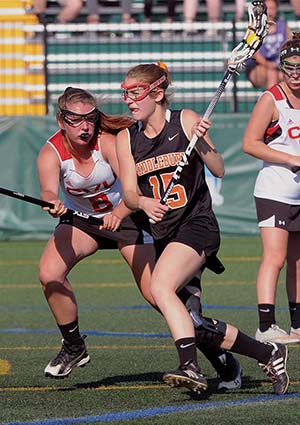
Looking Back, Ahead
It turned out Boe could and did do more than a few shifts, scoring within two minutes in the first game of her return, and contributing four goals during the Tigers’ successful playoff run. (She came back strong in the larosse playoffs, pictured at right. Independent file photo/Trent Campbell.)
But as successful and dramatic as that return became, Boe is not at full speed. In previous years Boe played midfield and defended tenaciously from end to end. On her return she played attack, limited to a third of the field when the Tigers were playing offense.
And after the title-game win, as happy as Boe was and as well as she had played, she summed up her abilities succinctly: “I’m not fast.”
Rosenberg explained the long-range recovery curve. If athletes are injured playing their primary sport, he said, they will still not be at full strength when the calendar flips to their sport again.
“I tell them, next season they’re going to be 80 percent at best. It really takes two years to get all your quickness back, all your confidence back,” Rosenberg said. “Six months is early.”
Rosenberg advised Boe to be patient when she started playing again, for example telling her to avoid heavy battles for loose balls. In general he said that determining when athletes should get back in action is always a tough question. After ACL surgery the risk of an athlete suffering a re-torn ACL is 15 percent higher than an original tear, per sports-health.com.
“We’re constantly trying to balance the athlete’s desire to return to the sport with the need to put the brakes on them because we know the knee is not 100 percent,” Rosenberg said. “It’s a huge debate in the sports medicine world, when is the right time to come back from surgery, and nobody has the right answer.”
Boe will be a walk-on to the Tufts lacrosse team, and said the coach understands her situation and has said she will get a second chance in the 2019-2020 academic year if she does not make the team this time around. At the very least Boe plans to play intramural sports; she admits not liking to sit around.
But her forced inactivity has given her perspective. She recalled Oakley Gordon, another three-sport standout who was two years ahead of her at MUHS and lost most of his senior year to an ACL injury.
She saw Gordon’s injury at a Tiger football home semifinal.
“I didn’t know him that well. And I had my couple days of feeling sorry for him, and then kind of I went on with my life, just like everyone else did,” Boe said.
She sees these injuries differently now. For example, Boe’s mother, Kathy Boe, said her daughter reached out to support another ACL victim last fall, Vergennes Union sophomore soccer player Emily Rooney.
As Andi Boe put it, “I felt so much more empathy for people like Oakley Gordon.”
Boe stayed with her teams after the injury, rarely missing a game and attending most practices, and she emphasized her friends and teammates supported her. She hopes all who know athletes in a similar position will do the same, and pledged herself to do more in the future.
“I definitely realized how much I brushed off everyone else’s injuries before I was hurt, for sure. Even just like seeing someone out for a week, I got it,” Boe said. “I know how much that is awful. It wasn’t, you’re out for a week and I’m out for nine months. I understand how hard it is to be out for a week for you.”
And she recommends to those in her shoes they devote themselves to rehab, both for their physical and mental health.
“Someone told me before I had the surgery it’s one-third what your doctor does and two-thirds what you do,” Boe said. “I think it’s good to know a couple things. One of which is obviously physically you need that to be able to come back at all, never mind six months or nine months or however soon you want to be back. And just like mentally, if you’re a high-level athlete who releases frustration and stuff through playing sports, then you still need to get from somewhere, and exercise and rehab is where I got that.”
Rosenberg, who had been watching Boe play soccer and lacrosse with his daughter Isabel since elementary school, called providing medical care for Boe both a special privilege and a responsibility.
And Rosenberg was there on the sideline, as he often is with his camera during Isabel’s games, when Boe scored 1:51 into the first game of her return.
“I went nuts. I yelled and she looked up at me and I gave her a fist pump and she gave me a big smile. It was awesome,” he said. “Honestly it was one of the most rewarding moments of my career.”
Andy Kirkaldy may be reached at andyk@addisonindependent.com.
